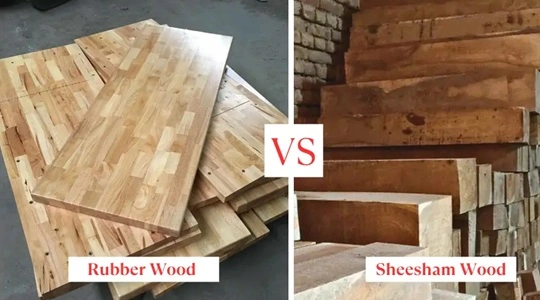While building furniture for your home or choosing wood for home interior décor, it is important to choose the right variety of wood. This will have an exceptional impact on the appeal, longevity, and general quality of the furniture. When it comes to preparing wooden furniture, rubber wood, and Sheesham wood are of significant use. Let us compare and contrast these two wood varieties and learn how best they help improve the home décor.
Rubberwood and its applications:
Rubberwood is a type of wood that is derived from the rubber tree. This wood is known for being more durable and robust, thus making it a popular choice for both flooring and furniture purposes. One of the most interesting things about rubberwood is that it serves as an eco-friendly option as it is prepared predominantly from trees that have already yielded rubber for other purposes. Rubberwood has a light color and is similar to beech wood. It is also very easy to work with, thus helping with various styles and finishes. Rubberwood is also resistant to cracking and warping, thus making it a practical choice for home construction requirements.
Pros of using Rubberwood:
1. Sustainability:
Approximately 10% of the forests in the world are cut down every year, and this cutting down of trees can negatively impact the environment, as it can deplete the fast-wood forests. This can result in soil erosions, floods, and landslides. Also, it can hasten the harmful effects of global warming. Harvesting the rubberwood can also mitigate these effects, as it protects the trees that could otherwise be burned.
2. Durability:
Rubberwood is flexible and is a durable hardwood, which belongs to the maple family. Rubberwood is actually very flexible and has a relative strength of 9500 psi. Its stiffness is nearly 1.3 million PSI and it has a harness of about 500 pounds.
3. Cost-effectiveness:
Rubberwood is largely considered to be a byproduct, and it is also sold at a lower price than most other varieties of wood. It is also durable and thus serves as a better option than maple, oak, cherry, and other varieties of wood.
4. Ideal for furniture making:
Rubberwood is extremely stable after processing as its cracking and shrinking are kept to a minimum. Thus, they are considered to be great for furniture and also feature an incredible blonde to medium tan color.
5. Absorbs stains:
Rubberwood is capable of taking up stains and finishes pretty well than other types of wood. This can be of tremendous use if we want to change its appearance to match our taste and settings.
Cons of Rubberwood:
- Perishable: Rubber wood is considered to be perishable, as it has a strong tendency to decay. It is also susceptible to staining from fungus and attacks from insects.
- Might increase latex allergies: People who are allergic to latex should refrain from using rubberwood.
- Twisting: While drying, rubber wood tends to twist and warp and might distort before drying. They are, however, sturdy and durable after they are seasoned.

Sheesham Wood:
Sheesham wood is one of the most widely used and famous types of wood that is highly helpful for designing furniture. They appear unique with a strong brownish-red color and also possess visible wood grains. They also feel dense and heavy in the hands and emit a specific scent to identify them.
Pros of Sheesham Wood:
1. Versatile:
Sheesham is classified as hardwood, and it is pliable. Its malleable and flexible nature makes it one of the best woods to work in. We can bend and shape it into different home décor furniture. Its grains are dense and dark and have golden hues, making the furniture design distinctive and appealing.
2. Cost-effective:
Though this wood has a lavish appearance, it is budget-friendly. It is possible to make cots, sofas, and other furniture at a relatively low price by using Sheesham wood. It is considered the best option for furniture, as its dark veins with contrasting golden and brown hues make the interiors look great.
3. Ideal for decorative carving:
Sheesham woods can be carved in different shapes, and we don’t have to worry about wood splintering or cracking after seasoning them.
4. Stability:
Sheesham woods are sturdy and are less prone to cracks. As they are kilned or dried in these un before making furniture, we need not worry about their stability and flexibility.
Cons of Sheesham wood:
- They are vulnerable to water and pest damage if they are not processed property. They can also retain moisture and attract termites and thus are not considered for making outdoor furniture.
- It might be hard to find the original Sheesham Woods.
Bottom Line:
Sheesham Woods is an ideal choice for making all types of indoor furniture. Their unique brownish-red hue and grain pattern help in adding warmth to any room. Rubberwood requires extensive seasoning to attain these qualities but is much more affordable than the latter, attracting a spectrum of customers.


